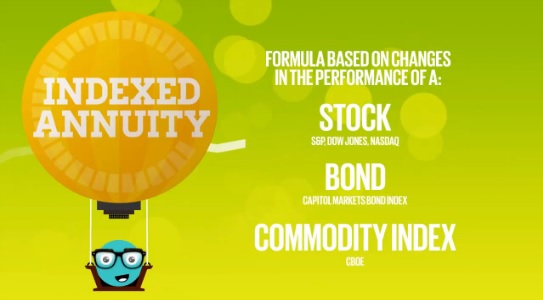 Check Out Our: >>Annuity Videos Most Common Usage: Long considered a CD alternative, annuities have become very popular today. Paying higher rates than CD’s and deferring taxes, many people on a fixed income find annuities are a better option than tying up money in CD’s or letting it warehouse in a money market account. Like a CD, you can place sums of money in annuities. You must leave the money in an annuity for a period of years. Depending on the annuity purchased, a yearly amount is allowed to be withdrawn without a penalty. This amount is usually around 10%. There are other annuity options, such as fixed payment annuities and even equity-indexed annuities. How Do Annuities Work?It’s a simple contract. You give the insurance company money. In exchange, the company promises to either pay you an interest rate on your money and your money grows like a savings account, or pay you a monthly income lasting for a period of time. Taking monthly payments is called annuitization. You have various options when choosing annuitization. This monthly income could last for a set number of years or for the rest of your life. An annuity may also be for the life of yourself and your spouse should you choose to do so. An annuity may also be left to the beneficiary at time of death. Most people begin receiving annuity income when they retire and continue receiving it for the rest of their life. Click Here For Video How Much Should I Invest in an Annuity?How much money you put into an annuity depends upon your financial goals and the type of annuity you are purchasing. In general, a traditional annuity should be considered for its ability to build tax-deferred earnings from otherwise taxable investments such as mutual funds and CD’s. An Equity Indexed Annuity should be purchased for participation in the stock markets while protecting principal from downside risk. Other AdvantagesBeyond tax advantages, there are important reasons to invest in an annuity, especially when you consider the limitations of other types of investments. Annuities can provide: – Guaranteed income. An annuity can provide you with a guaranteed lifetime income, regardless of how long you live. No other investment instrument can provide this guarantee. – Unlimited contributions. Unlike other tax-advantaged investments, such as IRAs, you can contribute an unlimited amount of money to an annuity during the year, whether in periodic installments or a lump sum. Individual carriers may place a ceiling on the total amount you may put into an annuity without approval. – Bonus rates. Some annuities award investors with bonuses-extra interest that further increase your investment – – at the end of your annuity’s first year. The bonus increases the annuity’s principal on which future interest will be calculated in subsequent years, thus providing a substantial boost to the ultimate value of an annuity fund. – No risk of loss. (“fixed” annuities) Unlike other forms of stock or fund investments, annuities that are invested in mutual funds or are tied to the stock market performance may include minimum guarantees to limit the amount of investment risk. – You can setup: An Annuity as a traditional IRA or as a Roth IRA. – No-penalty annual withdrawals. Most annuities have a provision that allows you to withdraw a certain amount per year penalty free. – No-penalty rollovers. Company pension or profit-sharing plan payouts may be reinvested without incurring taxes or penalties. – No probate in case of death, as long as you specify beneficiaries. Which means your family will find it easier and less costly to obtain the value of the annuity. – No initial sales charges (“no load”) or annual fees. Annuities are generally no-load, no-fee investments, which means more of your money is actually invested than with investments where some money is used to pay an initial or annual charge. – Shelter investments earnings. Retired people can use annuities to shelter investment earnings that would otherwise lead to lower Social Security benefits. TAX-DEFERRED ANNUITY. Annuities are not designed to be short term investments. The interest earned during the accumulation phase of an annuity is not taxed until distribution” which is usually at retirement. Overtime, the tax payment deferral provides a real financial advantage. ANNUITY CLASSIFICATIONS. Annuity contracts vary between insurance companies. Here are a few characteristics to look for when reviewing an annuity contract. An Immediate Annuity is opened with a single premium deposit. The lump sum deposit will generate a monthly income for a period of time chosen by the annuity owner. This type of annuity would be suitable for an individual at or near retirement or to support a surviving spouse and dependent children. a. Fixed Annuity. Under this approach, the insurance company guarantees the amount of the monthly payment. To fund this type of an annuity, the company will generally invest your premium payments in very low risk securities that emphasize protection of capital. This is necessary because the company has guaranteed a specific return and therefore cannot risk losing your money in speculative investments. This type of annuity is generally purchased by individuals who want the security of a known amount of annuity income each month. b. Fixed Equity-Indexed Annuity. An equity-indexed annuity is an annuity that earns interest that is linked to a stock or other equity index. One of the most commonly used indices is the Standard & Poor’s 500 Composite Stock Price Index (the S&P 500). How are they different from other fixed annuities? An equity-indexed annuity is different from other fixed annuities because of the way it credits interest to your annuity’s value. Most fixed annuities only credit interest calculated at a rate set in the contract. Equity-indexed annuities credit interest using a formula based on changes in the index to which the annuity is linked or a fixed account option. The formula decides how the additional interest, if any, is calculated and credited. The amount of additional interest you get and when you get it depends on the features of your particular annuity. Your equity-indexed annuity, like other fixed annuities, also promises to pay a minimum interest rate. The rate that will be applied will not be less than this minimum guaranteed rate even if the index-linked interest rate is lower. The value of your annuity also will not drop below a guaranteed minimum. For example, many single premium annuity contracts guarantee the minimum value will never be less than 90 percent (100 percent in some contracts) of the premium paid, plus at least 3% in annual interest (less any partial withdrawals). The insurance company will adjust the value of the annuity at the end of each term to reflect any index increases. Two features that have the greatest effect on the amount of additional interest that may be credited to an equity-indexed annuity are the indexing method and the participation rate. It is important to understand the features and how they work together. The following describes some other equity-indexed annuity features that affect the index-linked formula. Indexing Method The indexing method means the approach used to measure the amount of change, if any, in the index. Some of the most common indexing methods, which are explained more fully later on, include annual reset (ratcheting), high-water mark and point-to-point. Floor on Equity Index-Linked InterestThe floor is the minimum index-linked interest rate you will earn. The most common floor is 0%. A 0% floor assures that even if the index decreases in value, the index-linked interest that you earn will be zero and not negative. Advantages: Annual ResetSince the interest earned is “locked in” annually and the index value is “reset” at the end of each year, future decreases in the index will not affect the interest you have already earned. Therefore, your annuity using the annual reset method may credit more interest than annuities using other methods when the index fluctuates up and down often during the term. This design is more likely than others to give you access to index-linked interest before the term ends. c. Variable Annuity. The money an investor deposits in a variable annuity is invested primarily in a portfolio of equity securities. The annuitant participates in both the greater potential gain and the greater potential risk associated with equity securities. There is no guaranteed predetermined amount of monthly payout, but rather a payout which fluctuates depending on the portfolio’s performance. Because the risk is assumed by the investor instead of the insurance company, the variable annuity must be registered under the Investment Company Act of 1941. ANNUITIES AND CDs.Annuities and CDs have many similar characteristics. Both are sold by large financial institutions and insurance companies sell annuities while banks sell CDs; both provide a guaranteed return; and both have some degree of government oversight. Annuities, however, provide the following additional benefits: a. Liquidity. Annuities allow you to withdraw your money periodically and usually up to ten percent of the account value on an annual basis. On the other hand, CDs normally do not allow you to withdraw your funds until the CD matures. b. Taxes. The income earned by an annuity is not taxed until it is withdrawn. With CDs, taxes are paid when the interest income is earned regardless of the fact that the income will not be received until the CD actually matures. c. Returns. The returns earned by both investments are tied to prevailing market interest rates. Consequently, when rates go down the returns provided by CDs will be low. On the other hand, annuities generally provide a minimum level of return regardless of changes in market interest rates. THINGS YOU SHOULD KNOW a. Surrender Charges. Most policies have surrender charges for early termination. b. Taxes. Your money earns interest that is not subject to income tax until you withdraw it and usually at retirement when you may be in a lower tax bracket. c. Rating Services. Independent ratings provided by A.M. Best, Moody’s or Standard & Poor’s are a way to investigate the safety and soundness of the insurance company underwriting your annuity contract. d. Annuities Qualify For Direct Rollovers. Since January 1, 1993, if you receive any lump sum distribution from a company pension or profit sharing plan rather than having it transferred directly to another eligible plan, your employer is required to withhold 20% of the amount. You can avoid this withholding trap by having your money transferred directly into a qualified annuity. e. Annuities Escape Probate. Annuities do not have to go through probate when you die. Since an annuity is a life insurance contract, all of its proceeds are distributed immediately to the beneficiary under the terms of the contract, completely bypassing probate. The value of the annuity generally is included in your estate for estate tax purposes, but not for probate. | 
CNBC: Pros & Cons of Annuities Not one Fixed Index Annuity owner has ever lost their principal or profits from market volatility or insurance company failure. Not one time, not one dime! – Traditional market investments don’t offer this. – Banks can’t say this. – Bondholders can’t say this. – Money market owners can’t say this. – Real Estate investors can’t say this. – Precious metal investors can’t say this. – Variable annuity investors can’t say this. Use this site to get informed about Fixed Index Annuities – the ultimate smart-growth strategy.  |




